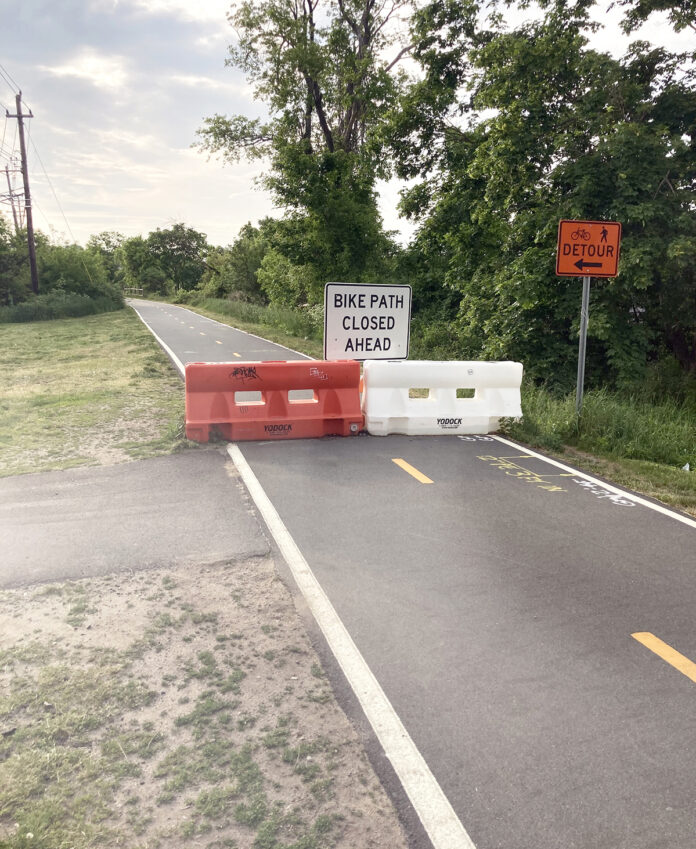The 18-month closure of two crucial bridges on the East Bay Bike Path has become a symbol of a larger problem in Rhode Island for many cyclists and other “active transportation” advocates.
The advocates worry that the R.I. Department of Transportation isn’t as committed to restoring pedestrian and bicycle bridges as it is to maintaining those used mostly by motorists.
Bicycle and pedestrian improvements are getting a fraction of the amount of money that is heading to traditional transportation improvements, such as pavement and road and bridge reconstruction, according to Scott Wolf, executive director of Grow Smart Rhode Island.
His organization estimates that pedestrian and bicycle improvements will get 1.8% of the total state transportation spending from 2022 to 2025, less than what had been proposed a few years ago. He sees the bike bridges in Barrington and Warren as symptomatic of a larger issue.
“The DOT’s lack of willingness to make a commitment to restore the bike bridges is unsatisfactory and is emblematic of a fairly consistent policy over the last several years of treating bike and [pedestrian] infrastructure as more of a nuisance than a policy,” Wolf said.
RIDOT Director Peter Alviti disputes that characterization. The state is spending more, not less, than it originally planned on pedestrian and bicycle improvements, he said, because it is spending a portion of its road and bridge budget on bike and pedestrian improvements. By his calculations, the state has spent $20 million annually since 2016 on active transportation, as opposed to the $13 million a year originally planned.
In 2019, RIDOT transferred $37 million in its 10-year, $4.7 billion plan from dedicated pedestrian and bicycle improvements into bridge construction. Alviti said he needed it to add pedestrian and bike improvements within those big projects.
Wolf described those improvements as superficial. “Those accommodations are usually pretty simple stuff like some striping or putting some paint on the side of the road,” he said.
The complaints about fairness came to a head this month, following a meeting organized by RIDOT to discuss an alternative to improve the detour for the East Bay Bike Path. Now, the detour is a “white-knuckler” that puts cyclists and walkers onto the same narrow sidewalk as they cross the Route 114 bridges over the Barrington and Palmer rivers, according to Keri Cronin, Warren’s Town Council president.
“It’s a free-for-all,” she said.
The improvement would create a new, separated area on the Route 114 bridges for cyclists as they cross the rivers, according to Alviti.
Whether the closed bridges, which didn’t allow vehicles, are ever reopened is a question. They were closed after state engineers found dangerous structural decay in them.
Repairing them will cost more than $25 million, Alviti said. The state has set aside $10 million. He hasn’t decided whether replacing the bike path bridges makes fiscal sense.
“There are people who have an attachment to the two railroad bridges. They like their two bridges and they want them back,” he said. “That is not always the correct answer to solving the problem.”
For riders, there is no question. The bridges are a part of the relaxing experience of riding a bike away from motor traffic, said Traci Vaspol, a bike commuter who takes the bus to her job at Rhode Island School of Design and then bikes home 16 miles to Portsmouth. “They have to be reopened,” she said of the bike path bridges.
Cronin, who has a retail store in Warren, said tourism will be impacted if the bridges aren’t restored. “This is a real issue that impacts the entire economic opportunity and health of the East Bay,” she said.
Mary MacDonald is a PBN staff writer. Contact her at Macdonald@PBN.com.












